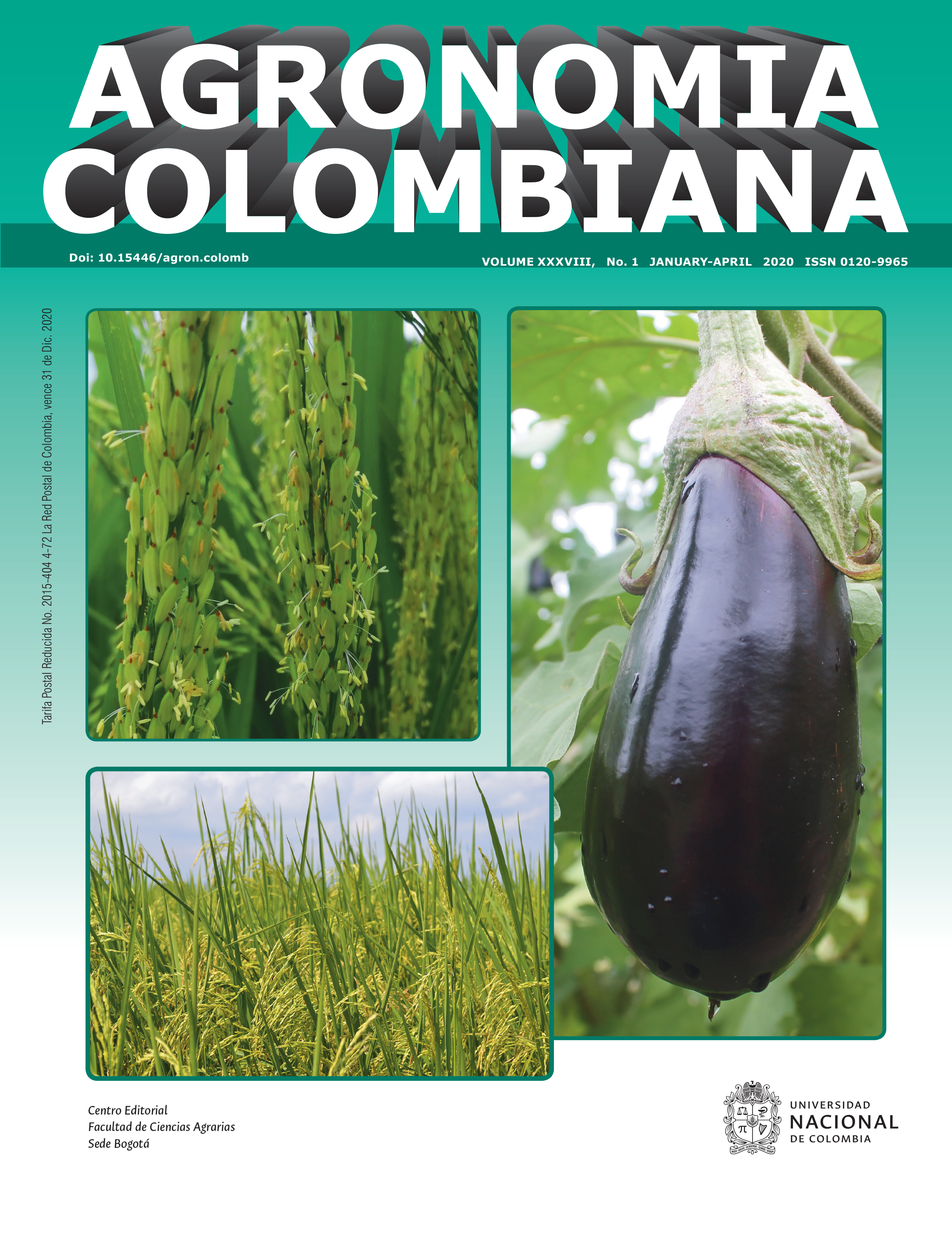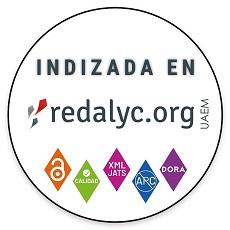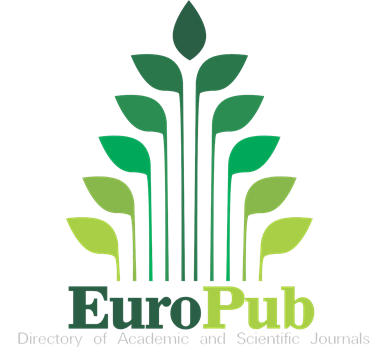Development and validation of severity scales of avocado wilt complex caused by Phytophthora cinnamomi, Verticillium dahliae and hypoxia-anoxia disorder and their physiological responses in avocado plants
Desarrollo y validación de escalas de severidad del complejo marchitez del aguacate causado por Phytophthora cinnamomi, Verticillium dahliae y el desorden hipoxia-anoxia y sus respuestas fisiológicas en plantas de aguacate
DOI:
https://doi.org/10.15446/agron.colomb.v38n1.78527Keywords:
epidemiological analysis, disease measurement, severity calibration, inoculum, disease management (en)análisis epidemiológico, medición de enfermedad, calibración de la severidad, inóculo, manejo de la enfermedad (es)
Downloads
Avocado wilt complex (AWC) is the most important disease in this crop. AWC may be caused by different causal agents that induce similar symptoms. Accurate scales of disease development (SDD) and physiological changes may be of special importance for the diagnosis and management of AWC. The objective of this work was to design and calibrate a specific SDD for the most common causal agents associated with AWC in Colombia,
Phytophthora cinnamomi Rands and Verticillium dahliae Klebahn, and the hypoxia-anoxia disorder in both seedlings in net house and adult plants under field conditions. Furthermore, physiological responses to infection were determined. The disease was monitored under field and net house conditions. Shoot symptoms were recorded and quantification of inoculum
in infected soil and tissue was performed. The visual scale was described based on external symptoms and calibrated with the inocula values by regression analysis. In the net house, net photosynthesis, stomatal conductance, and transpiration were measured during the different stages of disease development. The three causal agents induced a progressive reduction of net photosynthesis, stomatal conductance, and transpiration. The designed scales can be a valuable tool for epidemiological use
and support in the diagnosis and management of AWC.
más comunes asociados al CMA en Colombia, Phytophthora cinnamomi Rands y Verticillium dahliae Klebahn, y el desorden hipoxia-anoxia en plántulas de invernadero y plantas adultas en condiciones de campo. Además, se determinó la respuesta fisiológica durante la infección. La enfermedad se monitoreó en condiciones de campo e invernadero. Los síntomas de la parte aérea de la planta fueron registrados y se cuantificó el inóculo en el suelo y tejido afectado. Se describieron las escalas visuales
basadas en síntomas externos las cuales fueron calibradas con la cantidad de inóculo mediante análisis de regresión. En invernadero, se midieron la fotosíntesis neta, la conductancia estomática y la transpiración durante diferentes etapas del desarrollo de la enfermedad. Los tres agentes causales de enfermedad indujeron una reducción progresiva de la fotosíntesis neta, la conductancia estomática y la transpiración. Las escalas
diseñadas pueden ser una herramienta valiosa para su uso epidemiológico y de apoyo en el diagnóstico y manejo del AWC.
References
Barnett, H.L. and B.B. Hunter. 1972. Illustrated genera of imperfect fungi. Burgess Publishing Company, Minnesota, USA.
Bingham, F. and G. Zentmyer. 1954. Relation of hydrogen-ion concentration of nutrient solution to Phytophthora root rot of avocado seedlings. Phytopathology 44, 611-614.
Coffey, M. 1991. Cause and diagnosis avocado root rot. California Grower 15 (3), 17-23.
CuiYing, L., B. TuanHui, M. FengWang, and H. MingYu. 2010. Hypoxia tolerance and adaptation of anaerobic respiration to hypoxia stress in two Malus species. Sci. Hortic.124 (2), 274-279. Doi: 10.1016/j.scienta.2009.12.029
Darvas, J., J. Toerien, and D. Milne. 1984. Control of avocado root rot by trunk injection with Phosethyl-Al. Plant Dis. 68(8), 691-693. Doi: 10.1094/PD-68-691
Erwin, D.C. and O.K. Ribeiro. 1996. Phytophthora diseases worldwide. American Phytopathological Society, Minnesota, USA.
Ezin, V., R.D.L. Pena, and A. Ahanchede. 2010. Flooding tolerance of tomato genotypes during vegetative and reproductive stages. Braz. J. Plant Physiol. 22(2), 131-142. Doi: 10.1590/S1677-04202010000200007
Gisi, U., G.A. Zentmyer, and L.J. Klure. 1980. Production of sporangia by Phytophthora cinnamomi and P. palmivora in soils at different matric potentials. Phytopathology 70(4), 301-306. Doi:10.1094/Phyto-70-301
Hardham, A.R. and L.M. Blackman. 2018. Phytophthora cinnamomi. Mol. Plant Pathol. 19(2), 260-285. Doi: 10.1111/mpp.12568
Holdridge, L. 1967. Life zone ecology. Tropical Science Center, San Jose.
Leitner, D., S. Klepsch, A. Knieß, and A. Schnepf. 2010. The algorithmic beauty of plant roots - an L-System model for dynamic root growth simulation. Math. Comput. Model. Dyn. Syst. 16(6), 575-587. Doi: 10.1080/13873954.2010.491360
Ploetz, R.R. and B. Schaffer. 1989. Effects of flooding and Phytophthora root rot on net gas exchange and growth of avocado. Phytopathology 79, 204-208. Doi: 10.1094/Phyto-79-204
R Development Core Team. 2019. R: The R project for statistical computing. URL: https://www.r-project.org (accessed 9 August 2019).
Ramírez-Gil, J. 2018. Avocado wilt complex disease, implications and management in Colombia. Rev. Fac. Nac. Agron. Medellin 71(2), 8525-8541. Doi: 10.15446/rfna.v71n2.66465
Ramírez-Gil, J.G., E. Gilchrist-Ramelli, and J.G. Morales-Osorio. 2017. Economic impact of the avocado (cv. Hass) wilt disease complex in Antioquia, Colombia, crops under different technological management levels. Crop Prot. 101, 103-115. Doi: 10.1016/j.cropro.2017.07.023
Ramírez-Gil, J.G., G.O. Martínez, and J.G. Morales-Osorio. 2018. Design of electronic devices for monitoring climatic variables and development of an early warning system for the avocado wilt complex disease. Comput. Electron. Agric. 153, 134-143. Doi: 10.1016/j.compag.2018.08.002
Ramírez-Gil, J.G. and J.G. Morales-Osorio. 2018. Microbial dynamics in the soil and presence of the avocado wilt complex in plots cultivated with avocado cv. Hass under ENSO phenomena (El Niño - La Niña). Sci. Hortic. 240, 273-280. Doi: 10.1016/j.scienta.2018.06.047
Ramírez-Gil, J.G. and J.G. Morales-Osorio. 2019. Polyphasic identification of preharvest pathologies and disorders in avocado cv. Hass. Agron. Colomb. 37(3), 349-263. Doi: 10.15446/agron.colomb.v37n3.78528
Reeksting, B.J., N.J. Taylor, and N. van den Berg. 2014. Flooding and Phytophthora cinnamomi: effects on photosynthesis and chlorophyll fluorescence in shoots of non-grafted Persea americana (Mill.) rootstocks differing in tolerance to Phytophthora root rot. S. African J. Bot. 95, 40-53. Doi: 10.1016/j.sajb.2014.08.004
Rodríguez, E., A. Caicedo, A. Enríquez, and J. Muñoz. 2017. Evaluation of tolerance to Phytophthora cinnamomi Rands in avocado (Persea americana Miller) germplasm. Acta Agron. 66(1), 128- 134. Doi: 10.15446/acag.v66n1.50705
Sanclemente, M.A., B. Schaffer, P.M. Gil, A.I. Vargas, and F.S. Davies. 2014. Pruning after flooding hastens recovery of flood-stressed avocado (Persea americana Mill.) trees. Sci. Hortic. 169, 27-35. Doi: 10.1016/j.scienta.2014.01.034
Seifert, K., G. Morgan-Jones, W. Gams, and B. Kendrick. 2011. The genera of Hyphomycetes. CBS-KNAW Fungal Biodiversity Centre, Utrecht, Netherlands. Doi: 10.3767/003158511X617435
Sterne, R.E., G.A. Zentmyer, and M.R. Kaufmann. 1977. Effect of matric and osmotic potential of soil on Phytophthora root disease of Persea indica. Phytopathology 67, 1491-1494. Doi: 10.1094/Phyto-67-1491
Stolzy, L., G. Zentmyer, L. Klotz, and C. Labanauskas. 1967. Oxygen diffusion, water, and Phytophthora cinnamomi in root decay and nutrition of avocados. J. Am. Soc. Hortic. Sci. 90, 67-76.
Wager, A. 1942. Phytophthora cinnamomi and wet soil in relation to the dying-back of avocado trees. Hilgardia 14 (9), 519-532. Doi: 10.3733/hilg.v14n09p517
Whiley, A., J. Saranah, K. Pegg, and P. Langdon. 1987. Influence of Phytophthora root rot on mineral nutrient concentrations in avocado leaves. Aust. J. Exp. Agr. 27(1), 173-177. Doi: 10.1071/EA9870173
White, T., T. Bruns, S. Lee, and L. Taylor. 1990. Amplification and direct sequencing of fungal ribosomal RNA genes for phylogenetics. pp. 315-322. In: Innis, A., D.H. Gelfand, J.J. Sninsky, and T.J. White. PCR Protocols: A guide to methods and applications. Academic Press, London. Doi: 10.1016/b978-0-12-372180-8.50042-1
Yin, D., S. Chen, F. Chen, Z. Guan, and W. Fang. 2010. Morphoanatomical and physiological responses of two Dendranthema species to waterlogging. Environ. Exp. Bot. 68(2), 122-130. Doi: 10.1016/j.envexpbot.2009.11.008
Zentmyer, G. 1949. Verticillium wilt of avocado. Phytopathology 39, 677-682.
Zentmyer, G. 1984. Avocado diseases. Trop. Pest Manage. 30, 677-682. Doi: 10.1080/09670878409370915
How to Cite
APA
ACM
ACS
ABNT
Chicago
Harvard
IEEE
MLA
Turabian
Vancouver
Download Citation
CrossRef Cited-by
1. Richard Solórzano-Acosta, Marcia Toro, Doris Zúñiga-Dávila. (2024). Effect of Co-Inoculation with Growth-Promoting Bacteria and Arbuscular Mycorrhizae on Growth of Persea americana Seedlings Infected with Phytophthora cinnamomi. Microorganisms, 12(4), p.721. https://doi.org/10.3390/microorganisms12040721.
2. Luis Felipe González-Concha, Joaquín Guillermo Ramírez-Gil, Guadalupe Arlene Mora-Romero, Raymundo Saúl García-Estrada, José Armando Carrillo-Fasio, Juan Manuel Tovar-Pedraza. (2023). Development of a scale for assessment of disease severity and impact of tomato brown rugose fruit virus on tomato yield. European Journal of Plant Pathology, 165(3), p.579. https://doi.org/10.1007/s10658-022-02629-0.
3. Joaquín Guillermo Ramírez-Gil, Juan Camilo Henao-Rojas, Juan Gonzalo Morales-Osorio. (2020). Mitigation of the Adverse Effects of the El Niño (El Niño, La Niña) Southern Oscillation (ENSO) Phenomenon and the Most Important Diseases in Avocado cv. Hass Crops. Plants, 9(6), p.790. https://doi.org/10.3390/plants9060790.
4. Joaquín Guillermo Ramírez-Gil, Juan Gonzalo Morales-Osorio. (2020). Integrated proposal for management of root rot caused by Phytophthora cinnamomi in avocado cv. Hass crops. Crop Protection, 137, p.105271. https://doi.org/10.1016/j.cropro.2020.105271.
5. Elizabeth García-León, Juan M. Tovar-Pedraza, Laura A. Valbuena-Gaona, Víctor H. Aguilar-Pérez, Karla Y. Leyva-Madrigal, Guadalupe A. Mora-Romero, Joaquín Guillermo Ramírez-Gil. (2024). Identification of the causal agent of Guar leaf blight and development of a semi-automated method to quantify disease severity. Tropical Plant Pathology, 49(6), p.825. https://doi.org/10.1007/s40858-024-00676-y.
6. Joaquín Guillermo Ramírez-Gil, Juan Gonzalo Morales-Osorio. (2021). Proposal for Integrated Management of Verticillium Wilt Disease in Avocado Cultivar Hass Crops. Agronomy, 11(10), p.1932. https://doi.org/10.3390/agronomy11101932.
Dimensions
PlumX
Article abstract page views
Downloads
License
Copyright (c) 2020 Agronomía Colombiana

This work is licensed under a Creative Commons Attribution-NonCommercial-ShareAlike 4.0 International License.
© Centro Editorial de la Facultad de Ciencias Agrarias, Universidad Nacional de Colombia
Reproduction and quotation of material appearing in the journal is authorized provided the following are explicitly indicated: journal name, author(s) name, year, volume, issue and pages of the source. The ideas and observations recorded by the authors are their own and do not necessarily represent the views and policies of the Universidad Nacional de Colombia. Mention of products or commercial firms in the journal does not constitute a recommendation or endorsement on the part of the Universidad Nacional de Colombia; furthermore, the use of such products should comply with the product label recommendations.
The Creative Commons license used by Agronomia Colombiana journal is: Attribution - NonCommercial - ShareAlike (by-nc-sa)

Agronomia Colombiana by Centro Editorial of Facultad de Ciencias Agrarias, Universidad Nacional de Colombia is licensed under a Creative Commons Reconocimiento-NoComercial-CompartirIgual 4.0 Internacional License.
Creado a partir de la obra en http://revistas.unal.edu.co/index.php/agrocol/.





















